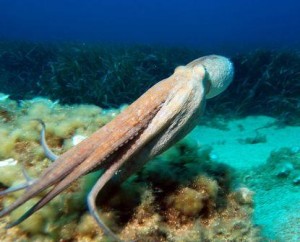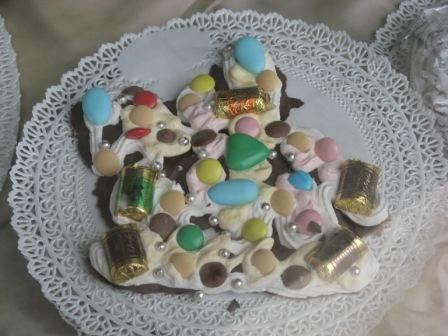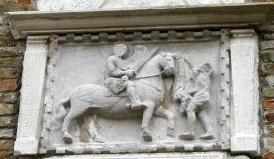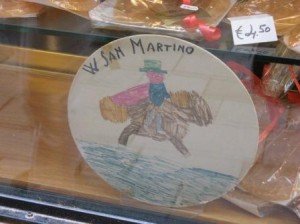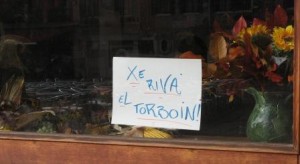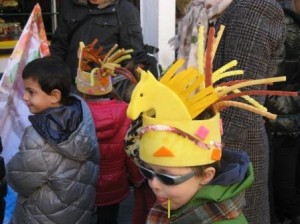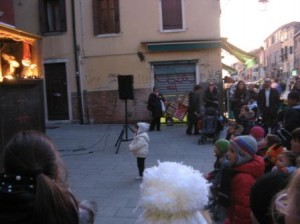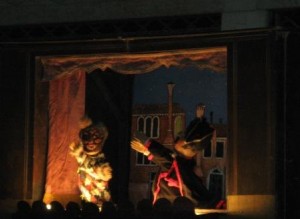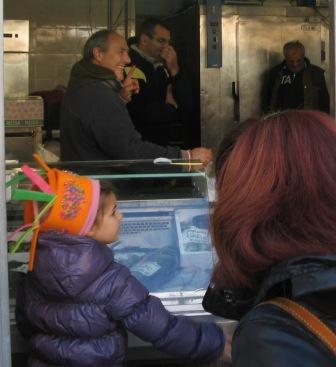
If I were to tell you (which I am) that another important holiday has just been upon us, you would be correct in asking me — before the history, the rituals, the weather — what we’re eating. As I write the house is full of an extraordinary aroma, which is only to be found during one or two days each year. If I were to try to describe it, you’d never want to eat it.
The feast-day (specifically November 21) is in honor of La Madonna della Salute, or Our Lady of Health. The nutriment is called castradina (kah-stra-DEE-nah) and it’s not for the faint of palate. Unlike frittelle at Carnival and bigoli in salsa at Redentore, this is not a dish that one finds made at home very much anymore — an American woman in the butcher shop who overheard me ordering the main ingredient told me that she wouldn’t have the “courage” to try making it. (Courage? It’s not like you have to club it to death. Besides, with something this strange, how would anybody know if it had gone wrong?)

Most important, it’s a dish that would be impossible to make at any other time of year because the principal component appears at the meatmongers only in mid-November and disappears even before the bridge is taken down at midnight and it will not be obtainable anywhere for another year “not even for ready money,” as the butler put it to Lady Bracknell. So even if you hate it, there is something appealing about its rarity, like one of those small creatures that are born, live, and die in the course of a single day. I happen to love it, but you know me.
Castradina is leg of mutton which has been dried, salted, smoked, and smeared with every spice which is black and odoriferous, and left to fester for only God knows how long. Hanging in the butcher shops they look like small prosciuttos which have just dragged themselves out of some basement apartment in Haight-Ashbury.
Under the Venetian Republic this product came from the flocks grazing the rocky heights of Dalmatia; today, much of it comes from the area of Sauris, in northeastern Italy next-door to Slovenia. Traditionally this meat — which obviously was treated in this intense way to withstand everything from ocean voyages to long-range bombardment — needs long, slow cooking. More than skill (or even courage), it requires time. And cabbage. I forgot to mention the verze sofogae, the suffocated cabbage.
I will give the recipe below, but I feel the need to move on to describe the feast-day itself. I find it very comforting because as there is Thanksgiving in November (with meat) in America, here there is thanksgiving in November (also with meat). So I don’t feel I’m missing any important element of the late autumn in all its dank, grey glory.
To understand why a church of the magnitude of Baldassare Longhena’s baroque basilica was built, we need to grasp, even slightly, the magnitude of the disaster it commemorates.
In 1630, Venice was hit with one of the worst plagues in her plague-ridden history. A mere 50 years earlier (1575-76) the city had managed to survive the scourge which inspired the church of the Redentore and its yearly festival of gratitude. Now, before the city had really recovered, the plague was back and it was even worse than before.
In that year plague had already been roaming around northern Italy, brought by German and and French soldiers fighting the Thirty Years’ War. They infected some of the Venetian troops, who took it to Mantova, where soon the disease had eliminated almost the entire city.
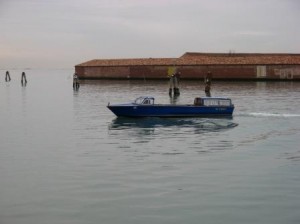
Venice was understandably cautious about contagion and was a pioneer in the business of quarantine, sequestering arriving ships, their crews and even their cargo for 40 days. The islands of Lazzaretto Vecchio and Lazzaretto Nuovo were dedicated to dealing with these cases, as well as some islands which have disappeared. For those unable to resist the romanticism of the idea of Venice sinking, I offer for pure, unadulterated melancholy the vision of an island (actually two: San Marco in Boccalama and San Lorenzo in Ammiana) which sank beneath the lagoon waves still containing the skeletons of the hundreds of poor bastards who were sent there to die. If Thomas Mann had known — or cared — about this, his famous novel with the irresistible title would not have had anything to do with a doomed infatuation at an expensive hotel but something much harsher in every way.
The situation in Venice was under control until an ambassador arrived from Carlo Gonzaga-Nevers, duke of Mantova. As everybody knew Mantova was already hugely infected with plague, the ambassador and his family were promptly quarantined on the island of San Clemente (now the site of the San Clemente Palace Hotel). All would have been well except that somebody thought it would be a good idea to send a carpenter over to see about some renovations that needed to be made to the ambassador’s quarters. Nothing wrong with that, but they let him go home. He brought the plague to San Vio, his neighborhood, and thence to the entire city.
By the time the epidemic was finally over 18 months later, 46,490 deaths had been recorded (some estimates go as high as 80,000) in a population of 140,000. The catastrophe was made even worse by the disproportionate number of pregnant women who died, and the fact that an epidemic of smallpox was also raging. So many people were dying each day that it was impossible to remove them all quickly; dead bodies simply lay about the streets, spreading contagion and panic.
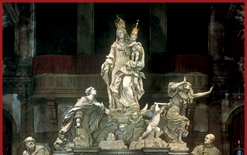
Desperate, the Doge and Senate, the Patriarch of San Marco and the people of Venice gathered in San Marco to pray for deliverance; they performed a solemn procession throughout the entire city for 15 successive Saturdays, carrying the miraculous icon of the Madonna Nicopeia which the Byzantine Emperor used to carry into battle at the head of his army. And the Senate made a vow to build a church to the Virgin, swearing that the people would go there every year to give thanks till forever, if she would intercede to save the city.
In November, 1631 the plague was declared officially ended, and they kept their promise, though it took 50 years to fulfill. In November, 1687, Longhena’s masterpiece was complete.
So every November 21 since 1631, Venetians have honored the Senate’s vow to give thanks and have gone to offer their thanks to the Madonna della Salute, Our Lady of Health, and to ask for her protection or intercession. A friend of mine makes a point of telling his doctor that the two euros he spends on a votive candle that day is the best money he spends on his health all year. I think he’s joking but I’m not sure.
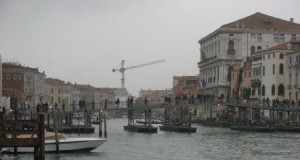
Temporary stalls are set up around the area in front of the church’s steps where vendors sell candles from delicate to dangerous. You buy your candle, take it into the church, and wait amid the throng until you’ve inched close enough to the candle-offering stations to give your candle to the harried, wax-spattered boys who are lighting new candles and blowing out old ones at a pretty steady clip. Not many candles stay lit for very long, but try not to let that matter to you. It’s the thought that counts.
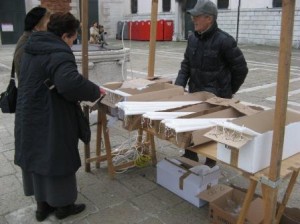
Masses are being said at intervals in the various side chapels, and also at the high altar. We manage to shuffle past the altar to the choir behind, and sit in some of the heavy carved wooden stalls for a while to watch the people leaving through the sacristy. As Lino says, if you stay there long enough you’ll see everybody go by. This is one day nobody wants to miss.
Especially the ladies in their fur coats. For many and various reasons, Venice in winter is one place where mink still reigns supreme. One night on the vaporetto I counted eleven (I did not make that up). Shearling and wool are fine, and down parkas abound. But women of a certain age and ilk are going to be in fur. If it can’t be mink, it’s going to be as damn close to it as they can manage.
November 21 appears to be the unofficial opening day of the mink-coat season. I think it’s because — as mentioned above — everybody is going to be at the basilica, hence it’s the ideal moment and place to present yourself in all your furry splendor. I have seen women in mink coats on the big day when the sun was shining and the temperature in the mid-50s. Sweat? Sure. Take it off? Never! I have a friend who refers to this as the feast of Our Lady of the Fur Coat.
Before we leave the subject of this brief but glorious holy day, I need to stress that all is not candles and sacred vows. Yes, children are brought by their relatives, and they go through the drill. But it’s going to be quite a few years before the Salute connotes sanctity to them and not cotton candy. Because behind and beside the church, along the rio tera’ dei Catechumeni, a series of stalls are set up which you can smell long before you see them. It’s fat-and-sugar Elysium: deep-fried frisbees of dough (think flat funnel cakes) slathered with Nutella, candied peanuts, big fat doughnuts, long ropes of that weird pinkish soft stuff that looks like a thread of marshmallow DNA, and cotton candy sticking to everything. Noise! Lights! Sugar shock! And lots of balloons of cartoon characters, close to — and sometimes just past — bursting with helium. All day long the town is scattered with kids trudging home with floating Spongebob Squarepants or Nemo and Marlin or Dalmatian dogs tied to their wrists.
I have no idea what little Venetian kids in 1690 might have been given after they trudged out of church with their parents, but I would bet (I would hope) that it was something with absolutely no nutritional value whatsoever.
CASTRADINA Prepare two days in advance.
Part One: “Suffocated cabbage” or Verze sofogae (VER-zeh so-fo-GAH-eh)
Buy a medium-sized cabbage, preferably the kind that has crinkly purple leaves. Why? Because it looks better. Otherwise, any cabbage.
Slice it into really thin strips, not too long. Put it in an anti-stick pot along with a modest amount of extra-virgin olive oil, a few knobs of garlic, a sprig or two of rosemary, a little salt. Mix to coat well. Put it on low heat and cover. Stir occasionally. Eventually the cabbage will reduce itself to one-third of its previous volume, and have become soft and almost velvety. Don’t try to help it along by adding water. Be patient.
Remove the garlic. Set aside till tomorrow (in the refrigerator, or even leave it on the stovetop if the kitchen isn’t too warm.)
Part Two: The castradina itself.
Buy a piece of castradina — half a leg is plenty for three people. A pound, more or less.
Put it in a large stockpot filled with cold water. Bring to a boil. Simmer for half an hour. (Considering what’s been done to it, it’s not like you have to actually cook it.)
Put the pot on the windowsill, or somewhere else that is reliably cool and leave it to cool down completely. It will probably be overnight.
The next morning: Skim off the congealed grease which has formed a soft layer on top of the liquid.
Add the cabbage. Bring to a boil and simmer for an hour or so.
To serve: You can either serve the soup first, then a piece of the meat, or you can put them all together in the bowl. I haven’t heard of any myth, etiquette, or rule governing this. Just make sure it’s steaming hot. That’s part of its gestalt.
The reason why it has to be hot is because back in the centuries when castradina was a normal thing to eat, before it became a semi-exotic semi-relic, people ate it all winter long for the simple reason that it was one great way to warm up. You might like cocoa, or even mulled wine, but for a typical Venetian winter day/night you used to need to bring out the heavy culinary guns. Blastingly hot castradina was born for this.


